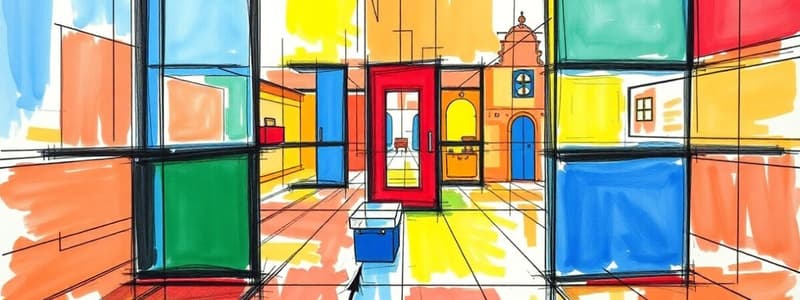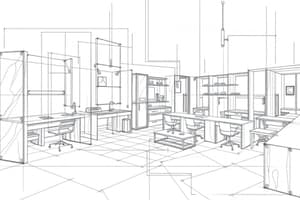Podcast
Questions and Answers
Which of the following shapes does not have edges?
Which of the following shapes does not have edges?
- Cube
- Cylinder
- Sphere (correct)
- Prism
A prism is a type of surface that can be both curved and have edges.
A prism is a type of surface that can be both curved and have edges.
False (B)
What is used in multiview drawings to indicate the existence of a hidden edge?
What is used in multiview drawings to indicate the existence of a hidden edge?
Hidden line
In a multiview drawing, the projection of an object is often represented using a __________ concept.
In a multiview drawing, the projection of an object is often represented using a __________ concept.
Match the following terms with their definitions:
Match the following terms with their definitions:
What shape does a circular hole transform into when distorted?
What shape does a circular hole transform into when distorted?
A right angle can only become a right angle in perspective drawing.
A right angle can only become a right angle in perspective drawing.
What is the primary purpose of multiview drawing?
What is the primary purpose of multiview drawing?
The glass box concept refers to the __________ of the planes of projection.
The glass box concept refers to the __________ of the planes of projection.
Match the following views with their correct descriptions:
Match the following views with their correct descriptions:
Which method helps in creating multiview drawings?
Which method helps in creating multiview drawings?
Depth, width, and height are necessary to fulfill an object's description in multiview drawing.
Depth, width, and height are necessary to fulfill an object's description in multiview drawing.
An edge is a line that represents the boundary between two __________ of an object.
An edge is a line that represents the boundary between two __________ of an object.
What is used to represent the projection of an inclined line?
What is used to represent the projection of an inclined line?
In a multiview drawing, oblique and inclined lines are projected in the same manner.
In a multiview drawing, oblique and inclined lines are projected in the same manner.
What is the primary purpose of the miter line in transferring depth?
What is the primary purpose of the miter line in transferring depth?
A curved surface can either __________ with an adjacent plane or curve surface.
A curved surface can either __________ with an adjacent plane or curve surface.
Match the projection types with their descriptions:
Match the projection types with their descriptions:
Which angle is typically preferred when using a miter line?
Which angle is typically preferred when using a miter line?
The glass box concept is not applicable for drawing projections of curved surfaces.
The glass box concept is not applicable for drawing projections of curved surfaces.
What must be preferred between front and side views when transferring depth?
What must be preferred between front and side views when transferring depth?
What happens in a multiview drawing when there is an intersection?
What happens in a multiview drawing when there is an intersection?
In a tangential relationship within a multiview drawing, a line is always present.
In a tangential relationship within a multiview drawing, a line is always present.
What types of planes should be identified in a multiview drawing?
What types of planes should be identified in a multiview drawing?
The precedence of lines from highest to lowest importance is visible line, hidden line, __________, and construction line.
The precedence of lines from highest to lowest importance is visible line, hidden line, __________, and construction line.
Match the following line types with their definitions:
Match the following line types with their definitions:
What should be altered to observe changes in a multiview drawing?
What should be altered to observe changes in a multiview drawing?
When coinciding lines appear, the hidden line is prioritized over the visible line.
When coinciding lines appear, the hidden line is prioritized over the visible line.
What is the purpose of matching lines to the object's features in multiview drawing?
What is the purpose of matching lines to the object's features in multiview drawing?
What is the primary purpose of a hidden line in drawings?
What is the primary purpose of a hidden line in drawings?
A center line can extend beyond the views it connects.
A center line can extend beyond the views it connects.
What shapes can the intersection between hidden lines form?
What shapes can the intersection between hidden lines form?
A center line in a circular view should cross at the __________ of the circle or arc.
A center line in a circular view should cross at the __________ of the circle or arc.
Match the following line types with their characteristics:
Match the following line types with their characteristics:
What should a hidden line do in relation to a visible line?
What should a hidden line do in relation to a visible line?
Center lines for small holes are always represented as dashed lines.
Center lines for small holes are always represented as dashed lines.
What space should be left when a center line continues with a visible line?
What space should be left when a center line continues with a visible line?
Which of the following correctly describes a spoke?
Which of the following correctly describes a spoke?
The section lines are always included in the section view of a rib, web, and lug.
The section lines are always included in the section view of a rib, web, and lug.
What is the purpose of a conventional break in drawings?
What is the purpose of a conventional break in drawings?
An aligned section is drawn by imaginary rotating the object's features about the __________ axis.
An aligned section is drawn by imaginary rotating the object's features about the __________ axis.
Match the following terminologies with their correct definitions:
Match the following terminologies with their correct definitions:
Which section view representation is omitted when the cutting plane is passed longwise through a spoke?
Which section view representation is omitted when the cutting plane is passed longwise through a spoke?
A web can have section lines included in its section view regardless of the cutting plane orientation.
A web can have section lines included in its section view regardless of the cutting plane orientation.
What is a lug in the context of conventional practice?
What is a lug in the context of conventional practice?
Flashcards are hidden until you start studying
Study Notes
Shapes and Edges
- A sphere is a shape that does not have edges.
- A prism can have both curved surfaces and edges.
Multiview Drawing
- Hidden lines are used to indicate the existence of an edge that is not visible in a particular view.
- The glass box concept is often used in multiview drawings to represent the projection of an object.
- Orthographic projection is a method used in multiview drawing to project an object onto a plane.
- Depth, width, and height are essential for accurately describing an object in a multiview drawing.
- Edges are lines that represent the boundary between two surfaces of an object.
- Oblique and inclined lines are projected in the same manner in a multiview drawing.
- Intersection occurs in a multiview drawing when two or more lines or surfaces meet.
- Tangential relationships in multiview drawings involve a line that touches a surface without crossing it.
- Visible lines, hidden lines, center lines, and construction lines are all important elements in multiview drawings.
- Matching lines to the object's features helps maintain accuracy and clarity in multiview drawings.
Line Types and Representations
- A hidden line represents a feature that is not visible in the current view.
- A center line is used to indicate the center of a symmetrical feature and can extend beyond the views it connects.
- Construction lines are used as guides during drawing process and are usually lighter than other lines.
- Section lines are used to show a cross-section of an object and are often used for objects like ribs, webs, and lugs.
Miter Lines and Depth Transfer
- The miter line is used to transfer depth between views.
- A 45-degree angle is typically preferred when using a miter line.
- The front view is generally preferred over the side view when transferring depth.
Curved Surfaces and Projection
- Curved surfaces can either intersect with an adjacent plane or curve surface or be tangential to them.
- The glass box concept is not applicable for drawing projections of curved surfaces because the projections can be distorted.
Sections and Break Lines
- Conventional breaks are used in drawings to avoid drawing out unnecessary details.
- A section view shows the internal detail of an object.
- Section lines are used to show a cross-section of an object.
- Aligned sections are drawn by imagining the object's features rotating around a specific axis.
- Lug is a protruding feature typically found for connecting to other parts.
Studying That Suits You
Use AI to generate personalized quizzes and flashcards to suit your learning preferences.




